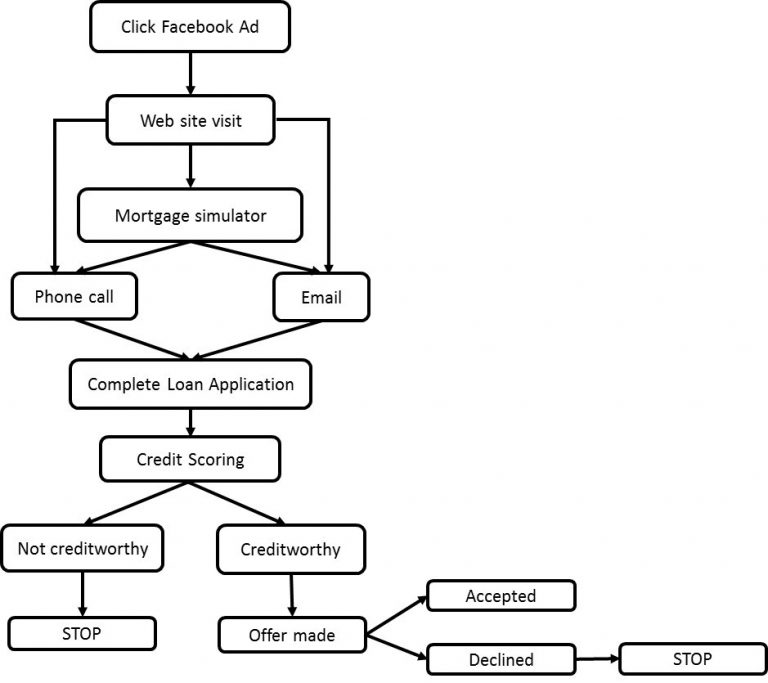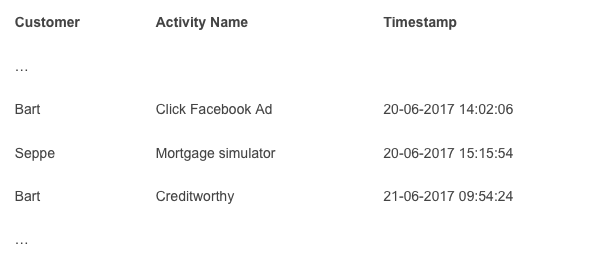A customer journey is a diagram representing the various steps the customers go through when engaging with a firm (Richardson, 2010). Figure 1 shows an example of a simplified customer journey for a mortgage sales process. It illustrates the various activities, states and transactions that a customer can be in when buying a mortgage. Transition probabilities and time indicators are usually added for further enrichment of the analysis.

Figure 1 Customer journey in a mortgage sales process.
Customer journey analysis serves various business purposes. It can be used to get a clear and comprehensive picture of the overall process and highlight process deficiencies such as excessive processing times, deadlock situations, circular references, unwanted customer leakage, etc. It can also be used to verify if the process is compliant with both internal and external regulation.
From an analytical perspective, sequence rules can be a first approach to discover customer journeys. A more mature discipline of analytical techniques for customer journey mapping is the field of process mining and discovery (van der Aalst, 2016). The idea here is to start from an event log of activities as depicted in Table 1. The event log depicts a unique customer identifier, the various activity names and timestamps. Process discovery techniques such as HeuristicsMiner (De Weerdt et al. 2012) or Fodina (vanden Broucke et al. 2017) can then be used to discover the underlying process model or customer journey. For more information on process mining and discovery techniques, we refer to van der Aalst (2016).

Table 1 Event log of customer activities.
Various challenges arise when doing customer journey analysis. First of all, it is important that all events are properly tracked across the various customer touch points using e.g. JavaScript plug-ins. It is recommended to capture all events at the lowest level of granularity. During the analysis, the complexity can be reduced by using appropriate aggregation operations as decided in collaboration with the business user. Furthermore, a customer should be uniquely identifiable across all touch points such that the corresponding information can be correctly matched.
Many firms will start doing customer journey analysis by focusing on one channel only, such as the web. Using data collected through JavaScript page tagging, web logs and cookies, firms can do clickstream analysis and understand how customers navigate through their website. More specifically, they can find out where customers come from, what search engines and search terms they used (if any), what was their first page (also called landing page), what were the other pages in their session or visit, and where did they drop out and at what time. As another example, consider an on-line sales process which may consist of the following steps: add items to basket, check out, provide personal details, provide payment details, review order, and confirm order. Customer journey analysis can be used to analyze how long customers spend in each of these stages and where and whereto they drop out. The analysis can be further enriched by performing segmentation and considering how different segments of customers in terms of e.g. geographic region, referrer, or gender (if available) may have different customer journeys.
References:
De Weerdt J., De Backer M., Vanthienen J., Baesens B., A Multi-Dimensional Quality Assessment of State-of-the-Art Process Discovery Algorithms using Real-Life Event Logs, Information Systems, Volume 37, Issue 7, pp. 654-676, 2012.
Richardson A., Using Customer Journey Maps to Improve Customer Experience, Harvard Business Review, 2010.
van der Aalst, W. M. P., Process Mining: Data Science in Action, Springer-Verlag, Heidelberg, 2016.
vanden Broucke, S. K. L. M., De Weerdt J., Fodina: a robust and flexible process discovery technique, http://www.processmining.be/fodina/, 2017.